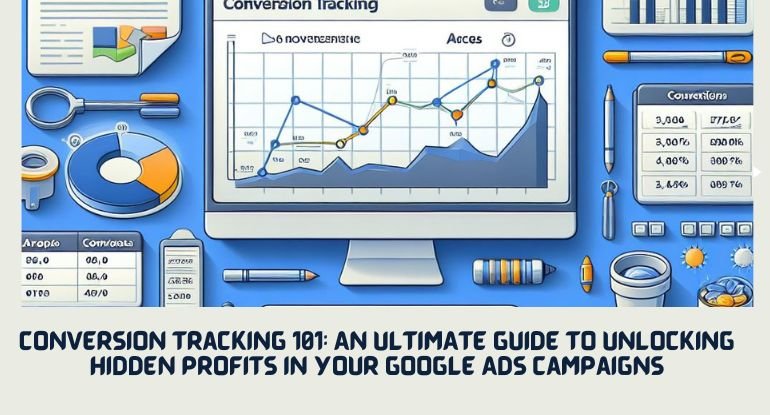Introduction
Imagine pouring money into a magic box, hoping for golden profits but never knowing what goes in or out. That’s what Google Ads can feel like without conversion tracking.
It’s like having a blindfold on in a treasure hunt – you might stumble upon riches, but you’ll miss most of them. So, let’s remove that blindfold and shed light on the magic of conversion tracking!
Countless marketers struggle to understand the true impact of their campaigns, blindly chasing clicks without knowing what actually converts into profit. But what if there was a secret weapon hidden within your Google Ads dashboard, waiting to unlock hidden profits and transform your campaigns from money-burners to profit-generating powerhouses?
That weapon is called conversion tracking.
Think of conversion tracking as the ultimate treasure map for your Ads campaigns. It shines a light on what actually works, revealing the hidden pathways that lead to conversions – those sweet, sweet sales, sign-ups, or downloads that make your business sing.
Without it, you’re essentially navigating in the dark, throwing darts at a blindfold-covered dartboard and hoping for a bullseye. So, how do you unlock this hidden treasure trove of data and turn your campaigns into profit-generating machines? Buckle up, because we’re about to embark on a conversion tracking adventure!
By the end of this insightful journey, you will be well equipped with knowledge and skills to track your Google Ads conversion, leading to bigger profits and a happier you.
What is Google Ads Conversion Tracking?

In simple terms, conversion tracking is a system that measures the real-world impact of your Google Ads campaigns. It goes beyond clicks and impressions, revealing the actions users take after interacting with your ads, like purchases, downloads, or sign-ups. This data is your treasure map, guiding you to optimize your campaigns for maximum profit and ROI.
Think of it like planting invisible seeds of data with your ads. When a user clicks on your ad and takes a desired action, the seed sprouts and blooms as a “conversion.” Conversion tracking tools capture these blooms, providing you with valuable insights such as:
- Which keywords and ads actually drive conversions? Ditch the duds and focus on the winners.
- What actions do users take after clicking your ads? Understand their journey and optimize the landing page experience.
- How much revenue do your campaigns generate? Measure ROI and make data-driven budgeting decisions.
What are the Benefits of Conversion Tracking?
Conversion tracking offers a treasure trove of benefits for your Google Ads campaigns, going far beyond simply counting clicks and impressions. Here are some key advantages:
#1. Bid and Budget Optimization with Laser Precision:
Imagine throwing darts blindfolded, hoping to hit the bullseye. That’s what your ad spend feels like without conversion tracking. But with it, you gain laser vision! You see which keywords actually drive purchases, downloads, or sign-ups, not just clicks. This lets you:
- Allocate more budget to high-performing keywords: Pour fuel on the fire where it matters most, boosting conversions and ROI.
- Stop wasting money on keywords that only generate clicks, not results. Redirect that budget to winning campaigns.
- Fine-tune bids for maximum impact: Set aggressive bids for top performers, while strategically lowering bids for less effective keywords, ensuring every penny gets the most mileage.
#2. Crafting Irresistible Ad Copy and Landing Pages
Think of your landing page as the final hurdle in your conversion race. Conversion tracking shows you which hurdles your users stumble over, allowing you to:
- Identify friction points: See where users drop off in the conversion funnel, like confusing forms or slow loading times.
- Tailor your ad copy: Craft messages that address user intent and expectations based on your conversion data.
- Optimize the landing page experience: Streamline the journey, remove roadblocks, and make conversions as effortless as possible.
#3. Measuring True ROI: From Clicks to Cold, Hard Cash
Are your Google Ads campaigns actually generating profit? Conversion tracking removes the guesswork, showing you the cold, hard cash your campaigns generate. This lets you:
- Justify your ad spend to stakeholders: Prove the value of your campaigns with tangible metrics, not just click counts.
- Identify profitable channels and campaigns: Focus your resources on what truly works and cut ties with underperformers.
- Set realistic goals and budgets: Base your future marketing decisions on data-driven insights, not wishful thinking.
#4. Gaining Invaluable Insights into Your Audience
Conversion tracking isn’t just about numbers; it’s about understanding your audience. You see which devices they use, what actions they take, and how they interact with your brand. This knowledge empowers you to:
- Identify trends and patterns: See how user behavior changes over time and adapt your campaigns accordingly.
- Target the right audience: Craft personalized ad experiences based on user demographics, interests, and conversion paths.
- Stay ahead of the curve: Test different strategies, refine your approach, and continuously improve your marketing magic.
Remember, conversion tracking isn’t just a tool; it’s a mindset. Embrace it, analyze your data, and watch your Google Ads campaigns transform from money-burners to profit-generating powerhouses!
Types of Google Ads Conversion Tracking
It’s easier than you think! Google offers a delicious spread of conversion tracking options to cater to your specific business needs. So, grab your plate and let’s explore!
#1. Website Conversions:
This is the classic of conversion tracking. You place a tiny code snippet on your website, and voila! You can track:
- Purchases: See how many clicks lead to sweet, sweet sales.
- Sign-ups: Count those email opt-ins and new account creations.
- Downloads: Track those eager clicks that lead to app downloads or ebook grabs.
- Form submissions: See who’s filling out your contact forms or surveys.
#2. App Conversions:
Got an app? You can track its success too! This type of tracking monitors user actions within your app, like:
- Installs: See how many clicks translate into downloads and app launches.
- In-app purchases: Track those virtual goods and subscriptions flying off the shelves.
- Level completions: Celebrate user progress and measure engagement.
- Specific app actions: Customize tracking to monitor any unique events within your app.
#3. Phone Call Conversions:
Not all leads come through the website. Phone calls are still a valuable touchpoint. Track them with Google forwarding numbers and see:
- Call duration: Get insights into how long conversations last.
- Number of calls: Measure the impact of call-only ads and phone-focused campaigns.
- Call source: Identify which ads or keywords are driving those valuable calls.
#4. Offline Conversions:
Sometimes, the magic happens outside the digital world. Track those offline wins with:
- Coupon code redemption: See how many online clicks lead to in-store purchases.
- Event registrations: Count those who sign up for your workshop or conference.
- Custom tracking methods: Develop specific tracking mechanisms for unique offline events.
Conversion tracking isn’t just a tool, it’s a superpower. It unlocks hidden profits, empowers data-driven decisions, and transforms your Google Ads campaigns from money-burners to profit-generating machines. So, take the blindfold off, embrace conversion tracking, and watch your marketing magic unfold!
Step-By-Step Guide to Track Google Ads Conversion

Step 1: Define Your Conversion Goals
Before you start digging for treasure, you need to know what you’re looking for. What actions do you want your ads to trigger? Is it a purchase on your website? A lead form submission? An app downloads? Define your conversion goals clearly, as they’ll guide your entire tracking setup.
- Go beyond the basics: Don’t just stop at purchases! Define micro-conversions like newsletter signups, product page visits, or video views. These smaller actions can lead to bigger goals and reveal valuable insights about user intent.
- Think multi-channel: Consider conversions across all touchpoints, not just website clicks. Track app downloads from ads, phone calls generated from call extensions, or in-store purchases triggered by online campaigns.
- Get specific: Set quantitative targets for each conversion goal. Aim for “10% of website visitors download our app” or “25% of lead form submissions convert into sales within 30 days.
Step 2: Set Up Conversion Tracking in Google Ads
Now, let’s grab the tools! Head over to the “Conversions” section in your Google Ads dashboard and choose your weapon of choice – website tracking, app tracking, or phone call tracking. Each has its own setup process, but the basic steps involve adding a snippet of code to your website or app, or setting up a Google forwarding number for phone calls.
Step 3: Track and Analyze Your Data
With your tracking beacon in place, it’s time to watch the magic unfold. Google Ads will now report on the beautiful dance between your ads and conversions. You’ll see how many clicks lead to conversions, which keywords and ad groups perform best, and even the specific actions users take on your website after clicking your ads. Remember to:
- Go beyond click-through rate (CTR): Analyze cost per conversion (CPA) and return on ad spend (ROAS) to measure true campaign effectiveness.
- Segment your data: Analyze conversions by device, demographics, or ad group to identify trends and optimize targeting for specific user segments.
- Use conversion funnels: Visualize the user journey from click to conversion, identify drop-off points, and optimize the landing page experience accordingly.
Step 4: Optimize, Tweak, and Conquer!
This is where the treasure starts to shine. Armed with your conversion data, you can now optimize your campaigns with laser precision. Ditch underperforming keywords, adjust bids for high-converting ones, and craft ad copy that speaks directly to your ideal customers. Watch your ROI soar as you eliminate wasted ad spend and focus on what truly drives profit.
Always remember that conversion tracking is a journey, not a destination. Regularly review your data, adapt your strategies, and experiment to continuously optimize your campaigns and unlock the full potential of Google Ads for maximum profit and success.
Conclusion
So, you’ve dipped your toes into the world of conversion tracking, and the possibilities are starting to shimmer like a chest of buried treasure. Now, it’s time to grab your shovel and start digging!
Don’t let the initial setup seem daunting. Start small, choose your conversion goals wisely, and watch the data whisper its secrets. Analyze, adapt, optimize – treat your campaigns like a garden, nurturing them with data-driven insights to blossom into lucrative gold mines.
Remember to share your conversion tracking challenges, tips and tricks in the comments below! Let’s build a community where we can all learn and grow together. Well done!










